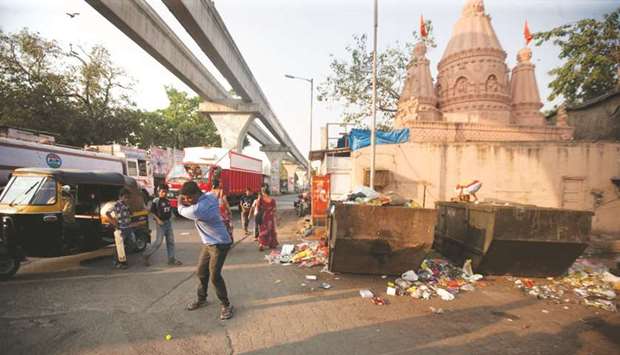Anil Bajrang Mane grew up in a slum in Chembur, a suburb of Mumbai. His home – a single 10ft x 10ftroom – was right over the wall from the 10th hole of the members-only Bombay Presidency Golf Club, which sprawls across 100 acres of land: prime real estate in a city where the average population density is 31,700 people per sq km.
When Mane was just 14, he dropped out of school to become a caddie on the other side of the wall. But it wasn’t until three years later, when he was 17, that he took his first swing, when a club member handed him a 7 iron and told him to have a go. The 150-yard shot changed his life, he says: he realised golf was his shot at fame and glory, the chance of a better life.
There was only one problem: the club didn’t allow caddies to play on the course, insisting it would detract from its “exclusivity”. Mane earned his livelihood in a world that wouldn’t allow him to participate. Every night, he would cross back from the verdant, genteel club into his own world of single-room tenements, corrugated tin rooftops and poverty.
“My mother’s health was frail and my father had suffered burns when a kerosene stove burst in our kitchen,” he says. “I had no option but to give up school and take up work.”
But that didn’t hurt his love for golf. So he and his friends perfected a different game, one they unironically call “slum golf”.
Slum golf is exactly what it sounds like: golf played in the narrow streets and alleyways of their informal community. The golfers sometimes dodge the street’s anatomy, but mostly they take advantage of it. Their “teeing ground”, “fairway” and “hazards” include houses, walls, drains, construction debris, parked vehicles, sleeping dogs, garbage dumps, stray cows and potholes. They play with cheap plastic ping pong balls and clubs made from construction rebar, fitted with hosepipe for grips.
When Mane and his friends play, they wager Rs50 (£0.54) a head. Winner takes the spoils.
The first hole is outside Mane’s friend Suresh Ramesh Mehboobani’s doorstep. Like Mane, Mehboobani was a caddie while living in the Sindhi Camp slum, this one originally a refugee settlement that borders the golf course.
“Slum golf is what we do for fun,” Mehboobani says. “It started out as a way to have a go at the game when the club rules didn’t allow caddies to play on the course.”
Although the club has since slightly relaxed its rules – it now allows caddies to use the club on Mondays, when it is closed to members – Mehboobani says they still play slum golf “for the fun of it, especially during the monsoon months, when the rains play havoc in Mumbai”.
So when the German golfer Norman Dick stumbled upon a YouTube video of Mane and his friends teeing off from a “hole” in the broken, rain-soaked concrete of their city, he immediately saw a younger, more energetic and freewheeling alternative to the stodgy golf played by middle-aged businesspeople, and decided he had to find a way to invite them to Paris for the World Urban Golf Cup.
Urban golf is not unlike slum golf: a guerrilla version of the game played in urban settings using the natural obstacles endemic to any city.
“In Europe, we have a wonderful community of urban golfers who meet at tournaments that take place on the streets of European cities,” Dick says. “All these tournaments have one thing in common. Everybody who wants to play, can play. Even if you don’t have the money, we find a way.”
He got in touch with Mane, Mehboobani and four fellow slum golfers and invited them to Paris to represent India. The European teams playing in the tournament collectively pitched in to pay for the Indian team’s flights, visas and hotel.
The tournament took place in September 2018, and of the 10 national teams the Indians came in fifth. Even more than the result, they enjoyed the experience as a glimpse of a life removed from their everyday realities in Mumbai.
“What I loved best about Paris is that we felt free. The streets were clean, the traffic was orderly, we could play golf on the streets without a care,” Mehboobani says. “We could even have a beer out in the open. When we stood fifth, the organisers surprised us with tickets to the Ryder Cup, where we got to see Tiger Woods play. That blew us away.”
Back in Mumbai, life goes on. Mane turned pro in 2010 and now teaches on the course, while most of his friends still caddie there, waking every morning at 5.30 to attend the lottery draw used to pick the day’s caddies. On a good day they stand to earn Rs1,000 (£11), tips included.
They dream of going pro like Mane, and indeed many professional players on the Indian circuit are former caddies from poor backgrounds. But professional tournaments are expensive to enter, often Rs50,000 (£550) or more, and while a fortunate few manage to find corporate sponsors, the others must rely on private support from generous club members.
Training, too, is expensive and time-consuming. “You need to hit at least 1,000 balls a day as part of your training to go pro,” says Mehboobani. He says it is a luxury most cannot afford.
Until then, they play slum golf. Mehboobani is the current undisputed champion. – Guardian News & Media

Slum golf u201chazardsu201d include houses, walls, drains, construction debris, parked vehicles, sleeping dogs, garbage dumps, stray cows and potholes. Photograph: Ritesh Uttamchandani/ Guardian News & Media


